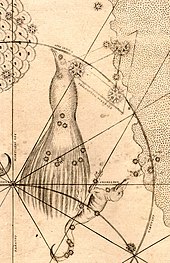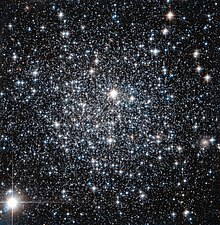天燕座
天球赤道座標:![]() 16h 00m 00s,−75° 00′ 00″
16h 00m 00s,−75° 00′ 00″
| 星座 | |
 | |
| 縮寫 | Aps |
|---|---|
| 所有格 | Apodis |
| 象徵物 | 天堂鳥[1] |
| 赤經 | 13h 51m 07.5441s – 18h 27m 27.8395s[2] |
| 赤緯 | -67.4800797° to -83.1200714°[2] |
| 家族 | 拜耳 |
| 面積 | 206平方度 (第67) |
| 主要恆星 | 4 |
| 拜耳/佛氏 恆星 | 12 |
| 有行星的恆星 | 2 |
| 亮度3m以上的恆星 | 0 |
| 距離在10秒差距(32.62光年)內的恆星 | 0 |
| 最亮星 | 異雀八 (3.83m) |
| 梅西爾天體 | 0 |
| 流星雨 | 0 |
| 鄰接星座 | 南三角座 圓規座 蒼蠅座 蝘蜓座 南極座 孔雀座 天壇座 |
| 可以看見的緯度範圍: +5°至−90°之間 最適合觀賞的月份:七月 | |
天燕座是南天小星座,名稱代表天堂鳥,在希臘語中原義為「無足」,因為人們一度以為天堂鳥沒有腳。1598年,彼得勒斯·普朗修斯率先在天體儀上劃出天燕座;1603年,約翰·拜耳將星座繪入《測天圖》;1756年,法國探險家兼天文學家尼可拉·路易·拉卡伊繪出天燕座並以拜耳命名法為其中最亮的星星命名。
天燕座最亮的五顆星均略呈紅色,其中最亮的異雀八為3.8視星等,是直徑約為太陽48倍,光度約926倍的橙巨星。接下來是略暗的異雀四,與異雀八一樣是衰老的巨星。異雀六是雙星,兩星相隔103角秒,均為肉眼可見。此外,人類已經發現天燕座的兩個恆星系統存在行星。
歷史[編輯]

荷蘭領航員兼探險家皮特·德克斯松·科瑟(Pieter Dirkszoon Keyser)和弗雷德里克·德·豪特曼(Frederick de Houtman)曾跟隨第一次荷蘭遠征印度尼西亞的船隊前往東印度,彼得勒斯·普朗修斯根據兩人的觀測結果首次劃定包括天燕座在內的十二星座,並於1598年印上35厘米直徑天體儀,與約道庫斯·洪第烏斯合作在阿姆斯特丹率先公布[3]。1603年,德·豪特曼將天燕座繪入南天星表,並為星座取名「天堂鳥」[4][5],普朗修斯為星座起名「Paradysvogel Apis Indica」,其中第一個詞在荷蘭語中意指天堂鳥,後人估計第二個詞「Apis」是印刷失誤,原本應該是「Avis」,意為「鳥」[4][1]。
除普朗修斯繪製的天體儀外,人類天體圖集中最早的天燕座記載是1603年約翰·拜耳的《測天圖》[3],拜耳為星座起名「Apis Indica」,天文學家約翰內斯·克卜勒和女婿雅各布·巴茨(Jakob Bartsch)起名「Apus」或「Avis Indica」[6]。「Apus」是希臘語「apous」的派生詞彙,意為「無足」,指天堂鳥。這主要是因為斐迪南·麥哲倫遠征隊的倖存者於1522年首次將天堂鳥標本帶回歐洲,這些標本都已去掉腳和翅膀,所以西方人普遍以為天堂鳥沒有腳。[1]天燕座此後近一個世紀的文獻記載很少,直到18世紀50年代尼可拉·路易·拉卡伊利用該座恆星定位南極座才改變局面[1]。
簡介[編輯]
天燕座占據0.5002%的天空,約為206.3平方度,在88個現代星座中排名第67[7]。星座位於南天球,只有北緯7度線以南才有可能看到整個星座[7][a]。天燕座北挨天壇座、南三角座和圓規座,西臨蒼蠅座和蝘蜓座,南接南極座,東交孔雀座。1922年,國際天文聯會確定星座的三字母縮寫為「Aps」[8]。1930年,尤金·德爾波特正式劃分天燕座邊界[b],是由六條線(包括弧線)組成的多邊形(見文首信息框)。根據赤道坐標系統,星座赤經位於13h 49.5m和18h 27.3m之間,赤緯位於−67.48°到−83.12°之間。[2]
顯著特點[編輯]
恆星[編輯]
拉卡伊採用拜耳命名法為天燕座12顆恆星分配從「α」到「κ」共十個希臘字母,其中「δ」和「κ」均代表兩顆距離非常近的恆星[6]。星座範圍內共有39顆恆星亮度超過或等於6.5視星等[c][7],異雀三、異雀四和異雀六組成狹小的三角形,異雀八位於三角形東側[11]。天燕座最亮的五顆星都略呈紅色,這在星座中頗為罕見[12]。
異雀八是距地球430±20光年的橙巨星,光譜等級K3III[13],亮度3.8視星等[14]。異雀八在藍白B型主序星階段的時間占該星目前生命絕大部分,目前已隨核心的氫耗盡開始擴張和冷卻,亮度也隨之提升[15]。經過擴張,異雀八的直徑已達太陽48倍[16],光度約為太陽的928倍,表面溫度4312K[17]。異雀三是4.2視星等[14]、距地球149±2光年的橙巨星[13],質量約為太陽1.84倍,表面溫度4677K[18]。異雀四是3.87視星等的黃巨星,距地球150±4光年,光譜等級G8III[13],光度約為太陽的63倍,表面溫度5279K[17]。異雀六屬雙星,兩顆星相隔103角秒,可用雙筒望遠鏡觀測[19]。其中偏亮的一顆距地球630±30光年,是光譜等級M4III的紅巨星[13],視星等在+4.66到+4.87範圍內變化[20],脈動周期有68天、94.9天和101.7天三種[21]。另一顆是光譜等級K3III的橙巨星[22],距地球550±10光年[13],視星等5.3。兩顆星均為肉眼可見[14]。
天燕座第五亮的恆星是4.8視星等的異雀一[12],同樣是膨脹並冷卻後形成的橙巨星,光譜等級K1III,表面溫度4649K,光度是太陽的133倍[17],距地球300±4光年[13]。異雀二就在異雀一旁邊,是距地球1040±60光年的聯星系統[13],包含兩顆相互圍繞旋轉的藍白主序星,公轉周期59.32年。兩顆星的質量都在太陽三倍以上,光譜等級分別是B9V和B9.5V。[23]
異雀七是距地球140.8±0.9光年的白主序星[13],質量是太陽的1.77倍,光度15.5倍,半徑2.13倍,現為4.89視星等。異雀七星齡2.5±2億年,正發射過量的24微米紅外輻射,估計是由距該星超過31天文單位的岩屑盤引起。[24]
天燕座θ是距地球350±30光年的冷卻紅巨星,光譜等級M7 III)[13],光度達到太陽的約3879倍,表面溫度3151K[17]。該星視星等有0.56的變化幅度,變化周期為119天[25]或近四個月[14]。受星風影響,天燕座θ每年流失的質量相當於太陽的1.1×10−7倍,流失的塵埃與周邊星際物質反應,隨恆星經過星系引發弓形震波[26]。HD 156513是光譜等級M3III的紅巨星,視星等在5.71至5.95範圍變化[27]。該星距地球780±20光年,光度估計達到太陽的2059倍,表面溫度3568K[17]。天燕座S是非常罕見的北冕座R型變星,是由兩顆白矮星合併而成所以含氫極少的超巨星,基準視星等為9.7,截至2012年,人類發現的這種變星尚不到一百顆[28]。天燕座R雖採用變星命名法命名,但實際上不是變星,而是5.3視星等的橙巨星[12]。
人類利用都卜勒光譜學發現天燕座的兩個恆星系統擁有行星,另外類太陽恆星HD 131664擁有棕矮星作為亞恆星級伴星,棕矮星質量經計算為木星的23倍。[29]HD 134606是類似太陽的黃色恆星,也是已經開始擴張並冷卻的主序星,光譜等級G6IV[30]。HD 134606周圍共有三顆行星,公轉周期分別是12天、59.5天和459天,距恆星越遠的行星尺寸越大[31]。光譜等級K2IV的HD 137388同樣是已經開始冷卻的主序星,溫度低於太陽[30],質量約為太陽的88%,光度僅為太陽的47%,估計星齡為74±39億年[32]。HD 137388的行星質量為地球79倍,公轉周期330天,與恆星的平均距離為0.89天文單位[33]。
深空天體[編輯]

天燕座大部分範圍由銀河系覆蓋[35],星座內的深空天體包括NGC 6101和IC 4499兩個顯著球狀星團,以及覆蓋異雀三和異雀四以東幾度天空的大規模暗淡星雲[36]。NGC 6101是9.2視星等的球狀星團,距地球約五萬光年[37],跨度約160光年。NGC 6101約有130億年歷史,集中大量人稱藍掉隊星的高亮度高質量恆星,估計藍掉隊星均由兩顆恆星合併而成[38]。IC 4499是位於中遠程銀暈的鬆散球狀星團[39],視星等為10.6[40]。
天燕座內的星系都很暗淡[36],IC 4633就是非常暗淡的螺旋星系,周圍由大量銀河系共同照耀星雲(Integrated Flux Nebula)環繞,估計這種暗淡的星雲是由大量恆星照亮[37]。
參見[編輯]
注釋[編輯]
參考資料[編輯]
- ^ 1.0 1.1 1.2 1.3 Ridpath, Ian. Apus. Star Tales. [2020-09-03]. (原始內容存檔於2020-07-25).
- ^ 2.0 2.1 2.2 Apus, constellation boundary. The Constellations (International Astronomical Union). [2020-09-03]. (原始內容存檔於2020-08-30).
- ^ 3.0 3.1 Ridpath, Ian. Johann Bayer's Southern Star Chart. Star Tales. self-published. [2020-09-03]. (原始內容存檔於2020-08-21).
- ^ 4.0 4.1 Ley, Willy. The Names of the Constellations. For Your Information. Galaxy Science Fiction. 1963-12: 90–99 [2020-09-03].
- ^ Ridpath, Ian. Frederick de Houtman's Catalogue. Star Tales. self-published. [2020-09-03]. (原始內容存檔於2020-08-21).
- ^ 6.0 6.1 Wagman, Morton. Lost Stars: Lost, Missing and Troublesome Stars from the Catalogues of Johannes Bayer, Nicholas Louis de Lacaille, John Flamsteed, and Sundry Others. Blacksburg, Virginia: The McDonald & Woodward Publishing Company. 2003: 30–32. ISBN 978-0-939923-78-6.
- ^ 7.0 7.1 7.2 7.3 Ridpath, Ian. Constellations: Andromeda–Indus. Star Tales. self-published. [2020-09-04]. (原始內容存檔於2020-08-21).
- ^ Russell, Henry Norris. The New International Symbols for the Constellations. Popular Astronomy. 1922, 30: 469. Bibcode:1922PA.....30..469R.
- ^ Ridpath, Ian. Constellation boundaries: How the modern constellation outlines came to be. Star Tales. self-published. [2020-09-04]. (原始內容存檔於2020-07-26).
- ^ Bortle, John E. The Bortle Dark-Sky Scale. Sky & Telescope. 2006-07-18 [2020-09-04]. (原始內容存檔於2020-08-29).
- ^ Thompson, Mark. A Down to Earth Guide to the Cosmos. New York, New York: Random House. 2013 [2020-09-04]. ISBN 978-1-4481-2691-0. (原始內容存檔於2020-09-04).
- ^ 12.0 12.1 12.2 Arnold, H.J.P; Doherty, Paul; Moore, Patrick. The Photographic Atlas of the Stars. Boca Raton, Florida: CRC Press. 1999: 144 [2020-09-04]. ISBN 978-0-7503-0654-6. (原始內容存檔於2020-09-04).
- ^ 13.0 13.1 13.2 13.3 13.4 13.5 13.6 13.7 13.8 Brown, A. G. A.; Gaia collaboration; et al. Gaia Data Release 2: Summary of the contents and survey properties. Astronomy & Astrophysics. 2018-08, 616. A1. Bibcode:2018A&A...616A...1G. arXiv:1804.09365
 . doi:10.1051/0004-6361/201833051.
. doi:10.1051/0004-6361/201833051.
- ^ 14.0 14.1 14.2 14.3 Ridpath, Ian. Stars and Planets Guide. Princeton, New Jersey: Princeton University Press. 2017: 78–79. ISBN 978-0-691-17788-5.
- ^ Kaler, James B. Alpha Aps. Stars. University of Illinois. 2007-04-06 [2020-09-04]. (原始內容存檔於2020-07-26).
- ^ Pasinetti Fracassini, L. E.; Pastori, L.; Covino, S.; Pozzi, A. Catalogue of Apparent Diameters and Absolute Radii of Stars (CADARS) - Third edition - Comments and statistics. Astronomy and Astrophysics. 2001, 367 (2): 521–524. Bibcode:2001A&A...367..521P. arXiv:astro-ph/0012289
 . doi:10.1051/0004-6361:20000451.
. doi:10.1051/0004-6361:20000451.
- ^ 17.0 17.1 17.2 17.3 17.4 McDonald, I.; Zijlstra, A. A.; Boyer, M. L. Fundamental Parameters and Infrared Excesses of Hipparcos Stars. Monthly Notices of the Royal Astronomical Society. 2012, 427 (1): 343–357. Bibcode:2012MNRAS.427..343M. arXiv:1208.2037
 . doi:10.1111/j.1365-2966.2012.21873.x.
. doi:10.1111/j.1365-2966.2012.21873.x.
- ^ Liu, Y. J.; Zhao, G.; Shi, J. R.; Pietrzyński, G.; Gieren, W. The abundances of nearby red clump giants. Monthly Notices of the Royal Astronomical Society. 2007, 382 (2): 553–566. Bibcode:2007MNRAS.382..553L. doi:10.1111/j.1365-2966.2007.11852.x.
- ^ Privett, Grant; Jones, Kevin. The Constellation Observing Atlas. New York, New York: Springer Science & Business Media. 2013: 13 [2020-09-04]. ISBN 978-1-4614-7648-1. (原始內容存檔於2020-09-04).
- ^ Watson, Christopher. Delta1 Apodis. The International Variable Star Index. American Association of Variable Star Observers. 2009-08-25 [2020-09-04]. (原始內容存檔於2020-07-26).
- ^ Tabur, V.; Bedding, T.R.; Kiss, L.L.; Moon, T.T.; Szeidl, B.; Kjeldsen, H. Long-term photometry and periods for 261 nearby pulsating M giants. Monthly Notices of the Royal Astronomical Society. 2009, 400 (4): 1945–1961. Bibcode:2009MNRAS.400.1945T. arXiv:0908.3228
 . doi:10.1111/j.1365-2966.2009.15588.x.
. doi:10.1111/j.1365-2966.2009.15588.x.
- ^ Houk, N.; Cowley, A. P. University of Michigan Catalogue of two-dimensional spectral types for the HD stars. Volume I. Declinations −90_ to −53_ƒ0. University of Michigan Catalogue of Two-dimensional Spectral Types for the HD Stars. Volume I. Declinations −90_ to −53_ƒ0. 1975. Bibcode:1975mcts.book.....H.
- ^ Docobo, J.A.; Andrade, M. Dynamical and physical properties of 22 binaries discovered by W. S. Finsen. Monthly Notices of the Royal Astronomical Society. 2013, 428 (1): 321–339. Bibcode:2013MNRAS.428..321D. doi:10.1093/mnras/sts045.
- ^ Plavchan, Peter; Werner, M.W.; Chen, C.H.; Stapelfeldt, K.R.; Su, K.Y.L.; Stauffer, J.R.; Song, I. New Debris Disks Around Young, Low-Mass Stars Discovered with the Spitzer Space Telescope. The Astrophysical Journal. 2009, 698 (2): 1068–94. Bibcode:2009ApJ...698.1068P. arXiv:0904.0819
 . doi:10.1088/0004-637X/698/2/1068.
. doi:10.1088/0004-637X/698/2/1068.
- ^ Yeşilyaprak, C.; Aslan, Z. Period-luminosity relation for M-type semiregular variables from Hipparcos parallaxes. Monthly Notices of the Royal Astronomical Society. 2004, 355 (2): 601–607. Bibcode:2004MNRAS.355..601Y. doi:10.1111/j.1365-2966.2004.08344.x.
- ^ Cox, N.L.J.; Kerschbaum, F.; van Marle, A.-J.; Decin, L.; Ladjal, D.; Mayer, A.; Groenewegen, M. A. T.; van Eck, S.; Royer, P.; Ottensamer, R.; Ueta, T.; Jorissen, A.; Mecina, M.; Meliani, Z.; Luntzer, A.; Blommaert, J.A.D.L.; Posch, Th.; Vandenbussche, B.; Waelkens, C. A far-infrared survey of bow shocks and detached shells around AGB stars and red supergiants. Astronomy & Astrophysics. 2012, 537: A35. Bibcode:2012A&A...537A..35C. arXiv:1110.5486
 . doi:10.1051/0004-6361/201117910.見table 1, IRAS 14003-7633.
. doi:10.1051/0004-6361/201117910.見table 1, IRAS 14003-7633.
- ^ Watson, Christopher. NO Apodis. The International Variable Star Index. American Association of Variable Star Observers. 2009-08-25 [2020-09-04]. (原始內容存檔於2020-07-26).
- ^ Tisserand; Clayton; Welch; Pilecki; Wyrzykowski; Kilkenny. The Ongoing Pursuit of R Coronae Borealis Stars: ASAS-3 Survey Strikes Again. Astronomy & Astrophysics. 2012, 551: 22. Bibcode:2013A&A...551A..77T. arXiv:1211.2475
 . doi:10.1051/0004-6361/201220713. A77.
. doi:10.1051/0004-6361/201220713. A77.
- ^ Reffert, S.; Quirrenbach, A. Mass constraints on substellar companion candidates from the re-reduced Hipparcos intermediate astrometric data: nine confirmed planets and two confirmed brown dwarfs. Astronomy & Astrophysics. 2011, 527: A140. Bibcode:2011A&A...527A.140R. arXiv:1101.2227
 . doi:10.1051/0004-6361/201015861.
. doi:10.1051/0004-6361/201015861.
- ^ 30.0 30.1 Gray, R.O.; Corbally, C.J.; Garrison, R.F.; McFadden, M.T.; Bubar, E.J.; McGahee, C.E.; O'Donoghue, A.A.; Knox, E.R. Contributions to the Nearby Stars (NStars) Project: spectroscopy of stars earlier than M0 within 40 pc-The Southern Sample. The Astronomical Journal. 2006-07, 132 (1): 161–170. Bibcode:2006AJ....132..161G. arXiv:astro-ph/0603770
 . doi:10.1086/504637.
. doi:10.1086/504637.
- ^ Schlaufman, Kevin C. Tests of in situ Formation Scenarios for Compact Multiplanet Systems. The Astrophysical Journal. 2014, 790 (2): 11. Bibcode:2014ApJ...790...91S. arXiv:1402.7075
 . doi:10.1088/0004-637X/790/2/91. 91.
. doi:10.1088/0004-637X/790/2/91. 91.
- ^ Bonfanti, A.; Ortolani, S.; Piotto, G.; Nascimbeni, V. Revising the ages of planet-hosting stars. Astronomy & Astrophysics. 2015, 575 (A18): 17. Bibcode:2015A&A...575A..18B. arXiv:1411.4302
 . doi:10.1051/0004-6361/201424951.
. doi:10.1051/0004-6361/201424951.
- ^ Dumusque, X.; Lovis, C.; Ségransan, D.; Mayor, M.; Udry, S.; Benz, W.; Bouchy, F.; Lo Curto, G.; Mordasini, C.; Pepe, F.; Queloz, D.; Santos, N. C.; Naef, D. The HARPS Search for Southern Extra-solar Planets. XXX. Planetary Systems around Stars with Solar-like Magnetic Cycles and Short-term Activity Variation. Astronomy & Astrophysics. 2011, 535: A55–A66 [2016-05-29]. Bibcode:2011A&A...535A..55D. arXiv:1107.1748
 . doi:10.1051/0004-6361/201117148. (原始內容存檔於2015-05-29).
. doi:10.1051/0004-6361/201117148. (原始內容存檔於2015-05-29).
- ^ IC 4499: A globular cluster's age revisited. ESA/Hubble Picture of the Week. [2020-09-04]. (原始內容存檔於2020-07-28).
- ^ Inglis, Mike. Astronomy of the Milky Way: The observer's guide to the southern Milky Way. New York, New York: Springer. 2004: 124–127 [2020-09-04]. ISBN 978-1-85233-709-4. (原始內容存檔於2020-09-04).
- ^ 36.0 36.1 Malin, David; Frew, David J. Hartung's Astronomical Objects for Southern Telescopes, with an Addendum for Northern Observatories: A Handbook for Amateur Observers. Melbourne, Victoria: Melbourne University Publishing. 1995 [2020-09-04]. ISBN 978-0-522-87124-1. (原始內容存檔於2020-09-04).
- ^ 37.0 37.1 Chadwick, Stephen; Cooper, Ian. Imaging the Southern Sky: An Amateur Astronomer's Guide. 2012: 240. ISBN 978-1-4614-4750-4.
- ^ O'Meara, Stephen James. Deep Sky Companions: The Caldwell Objects. Cambridge, United Kingdom: Cambridge University Press. 2003: 409–412. ISBN 978-0-521-82796-6.
- ^ Ferraro, I.; Ferraro, F.R.; Pecci, F. Fusi; Corsi, C.E.; Buonanno, R. Young globular clusters in the Milky Way: IC 4499. Monthly Notices of the Royal Astronomical Society. 1995-08, 275 (4): 1057–1076. Bibcode:1995MNRAS.275.1057F. doi:10.1093/mnras/275.4.1057.
- ^ Frommert, Hartmut. IC 4499. Students for the Exploration and Development of Space. [2020-09-04]. (原始內容存檔於2020-07-26).
外部連結[編輯]
| ||||||||||||||||||||||||||||||||||||||||||||||||||||||||||||
| |||||||||||||||||||||||||||||||||||||||||||||||||||||||||||||||||||||||||||||||||||||||||||||||||||||||
| |||||||||||||||||||||||||||||||||||||||||||||||||||||
